10 Best Home Renovators: Review, Pros and Cons, Quality and Price
The renovator can be safely called a unique tool that will be useful in a home or professional workshop.The device has many names, but a common one is multifunctional tool or MFI. The device appeared recently, but is gaining worldwide popularity among recognized professionals and replaces about 10 tools used in repair work.
The content of the article:
What to look for when choosing
The operating principle of the multifunctional tool is the use of an oscillating drive. Visually it resembles a small grinder or special angle drills for working in confined spaces. But, unlike these devices, which are designed for a small number of tasks, the renovator has a wide list of functions:
- Used as a saw or hacksaws for various materials. They purchase special attachments (depending on the configuration, they can be included in the set with the renovator). For sawing wood structure, the saw teeth are high and spread out to the sides. Before cutting the metal, insert a fine-toothed bit. The cutting part is hardened in the latter case.
- With the help of a renovator, the glued elements are torn off, and the surface is also cleaned of various coatings, such as paint. Vibrations, along with the rough surface of the nozzle, and a large contact area allow you to evenly clean the wall of wallpaper, remove plaster, and also remove rust.
- A popular task for which a renovator is used is grinding. With special attachments it is easy to sand and clean various surfaces. The renovator does not polish, for example, a headlight to a perfect shine, but he will even out small areas of metal and wooden chips.
- The renovator cuts holes of different depths and diameters that are suitable for fastening sockets, locks and door handles. Select elongated nozzles taking into account the diameter of the body in order to cut a recess of the required size.
- It is convenient for a renovator to clean seams and joints when working with tiles. Chips on ceramics are considered a “headache” for installers. The renovator will cope with shallow inclusions.
Advantages of a renovator:
- A big, obvious plus in savings. One tool includes several devices, which is economical. You don’t have to have a drill, a jigsaw, or a saw in your arsenal just to repair the baseboard or install an additional outlet once a year.
- Models equipped with a battery operate regardless of the location of the power source.
- As a rule, the weight of a renovator is from 1 to 2.5 kg, which means they work for a long time without getting tired.
- An assortment of different attachments is useful for various jobs.
They note that the MFI will not replace narrow-profile devices and is not suitable for massive materials. This is due to the fact that renovators are produced with an average power of up to 500 W, which is not enough to perform large-scale tasks. The multifunctional tool is divided into 4 groups according to power volume:
- Up to 100 W. “Weak” renovators, which are suitable for sanding non-rough surfaces, polishing or cutting soft materials such as rubber, linoleum or cardboard.
- Up to 200 W. A tool with such power is suitable for performing small jobs on soft materials, some types of metal.
- Up to 400 W. Refers to semi-professional renovators. Power allows you to work with both soft and hard materials.
- More than 400 W. Powerful models that work equally well with wood and metal.
For a renovator for a small home workshop and small one-time work, look at the following characteristics:
- Renovators are available with a power of 200-600 W. For working with light materials, such as wood or plastic, models up to 300 W are suitable. If it is necessary to process rough, heavy materials (brick, metal or concrete), then purchase a more powerful tool with a maximum value of up to 600 W (they do not sell more powerful ones on the Russian market).
- Speed of revolutions. Almost all models have built-in oscillation frequency control, and the speed range is 6-25 thousand rpm. Changing the speed allows you to quickly switch between tasks and work productively with different materials.
- There are 2 types of MFI power supply: battery, wired. The first type is wireless and runs on a built-in battery. This renovator is easy to use, especially in hard-to-reach places. The second type is classic - powered from the network. For such a renovator, it is necessary to separately purchase an extension cord, since the device’s cable is short.
- Additional functions. This includes additional protection against overheating (allows you to work safely without interruptions), connection to a construction vacuum cleaner (a convenient feature when working with concrete, tiles or stone), support for a given speed with power.
- Equipment. As with other instruments, there are different configurations. As a rule, sets differ in the number of attachments and the presence of additional items that are necessary when working with MFIs.
This is useful! How to hang tools on the wall in the garage.
The main advantage of a multifunctional tool is a large selection of attachments that allow you to perform different jobs. Types, functionality of kits:
- Wood saws.This type of nozzle comes in different shapes - straight, trapezoidal or semicircular. They also differ in the length of the teeth, sharpening (0.7-2.6 mm), and the type of material being processed (soft or hard wood). Using an MFI as a jigsaw will allow you to comfortably perform fine cutting work, which includes trimming door frames or cutting down skirting boards.
- For concrete. Special abrasive attachments with diamond or carbide coating, which are designed to work with tiles or porcelain stoneware, concrete or brick, as well as stone.
- For grinding surfaces. These attachments are shaped like a circle or a triangle, to which special abrasive sanding sheets or polishing sponges are attached. In renovators they are used for grinding, polishing, and removing dirt.
- For metal. Special saws for cutting metal workpieces that have a flat or semicircular shape. Such attachments are suitable for cutting nails, cutting small (up to 30 mm) pipes, and metal rods.
- Special gate nozzle. In renovators, it resembles a scraper, suitable for removing various contaminants from surfaces (for example, polyurethane foam, sealants or glue).
- Cutting knife. Pointed nozzle with double-edged edges. Convenient to use for cutting soft materials such as linoleum, rubber or cardboard.
Nozzles are purchased separately, but look at the markings, which indicate which materials are suitable for working with:
- Carbide - carbide coating for metal work;
- BIM - bimetallic nozzles for soft metal or wooden elements;
- HCS - high carbon mild steel for wood, plastic and various artificial materials;
- HSS - metal cutting steel;
- HM - carbide nozzles for tiles and porcelain stoneware, aerated concrete or fiberglass;
- CV - chrome vanadium steel for working with soft metals.
When determining which renovator attachment is best to buy, you need to check the markings, comparing them with the materials intended for use. To avoid receiving a defective device, you should first pay attention to the characteristics:
- For a quality renovator, the weight should be equally centered to prevent distortion and “pecking” during operation. This can lead to inconvenience and poor-quality cutting.
- In classic models, the wire must be well secured, without visible damage. In cordless tools, the battery is tightly inserted into the grooves and does not fly out.
- Switching speeds. The adjustment button should be located on the body to prevent accidental acceleration/braking during operation of the renovator. In addition, this element should not “stick” and be easy to switch.
- When purchasing wired models, take into account the length of the cord so that, if necessary, you can immediately purchase an extension cord.
This will come in handy! 14 Best Impact Drills for Home. The best cordless screwdrivers.
Rating of the best renovators
If you need the best renovator, do not forget about one more criterion - the correspondence of price to quality. Based on customer reviews and reviews from experts, the best rating includes 10 models from different manufacturers and prices suitable for both beginners and professionals.
BOSCH PMF
The BOSCH brand is known for quality. The renovator from this manufacturer of power tools and household appliances is no exception. A reliable device with a power of 130 W is suitable for both small and large-scale work. A speed controller from 0 to 20,000 rpm is conveniently installed on the MFI body.The weight of the tool is small (1.1 kg), so it is easy and comfortable to work with. However, the price is high and averages 16,500 rubles.
Advantages:
- vibration frequency adjustment;
- good equipment (case and attachments);
- proven brand;
- ease of control.
Flaws:
- the renovator is not compatible with attachments from other manufacturers;
- high price.
Makita TM3000C
Powerful (320 W) professional tool from the Japanese manufacturer Makita. The best among professional network renovators. The device body weighs 1.4 kg with comfortable rubber inserts, allowing you to work for a long time and comfortably without interruption. High power and adjustable vibration frequency in the range of 6000-20000 rpm ensure equally productive work with both soft and hard materials. The price of MFI in construction mass markets and online stores is about 11,500 rubles.
Advantages:
- the tool does not overheat and can be used without interruption for almost the whole day;
- high power;
- comfortable ergonomic body;
- installation of attachments from other brands;
- vibration damping system in the renovator.
Flaws:
- minimum equipment;
- high price.
DeWALT DWE315
A tool that is suitable for performing work of various sizes. On a convenient ergonomic body, which visually resembles a grinder, there is a speed controller in the range of 0-22000 rpm. The power of 300 W is productive for various types of work with hard and soft materials. In addition, the renovator is equipped with a flashlight for additional illumination of the surface being treated. The average price is 11,000 rubles.
Advantages:
- high power;
- additional protection against overheating;
- convenient attachment of attachments;
- installation of attachments from other brands;
- kit set;
- additional lighting.
Flaws:
- high price.
Metabo MT400
A powerful and at the same time compact renovator in an ergonomic housing from the Metabo brand. A good choice for both beginners and professionals. The quality is not inferior to popular analogues. In addition to battery operation, the tool can adjust the cutting angle. This makes working with profile workpieces convenient. With clear controls. High power of 400 W and oscillation frequency of up to 18,500 rpm allow you to work for a long time without interruptions and cut out hard and soft materials. The price of the device is 20,000 rubles.
Advantages:
- power above average;
- additional power maintenance function;
- compatibility of attachments from other brands;
- connecting a vacuum cleaner.
Flaws:
- high price.
DECKER MT300KA
A renovator from an American brand that combines quality with price. High power of 300 W, oscillation frequency of 10,000-22,000 rpm, low weight of 1.5 kg and good equipment, consisting of 11 additional attachments, allow you to work productively with different types of materials with virtually no interruptions. The renovator has an additional connection to an industrial vacuum cleaner.
Chip removal makes working with tiles, porcelain stones, concrete and brick dust-free. The ergonomic body allows you to work even in hard-to-reach places. The price of MFIs on well-known marketplaces is from 8,000 to 10,000 rubles.
Advantages:
- high power and speed;
- compact body;
- affordable price;
- ease of changing nozzles;
- good equipment.
Flaws:
- sensitive vibration when operating at high speeds.
Hammer LZK500
An inexpensive renovator that justifies the cost. Suitable for small jobs in the home workshop, best reviewed.Power of 250 W and speed in the range of 11000-21000 rpm will allow you to work efficiently with soft materials. However, the device is not suitable for metal work. The complete set of the renovator makes it possible to immediately start working without purchasing additional tools. The price of the device in construction and online stores is 5,500 rubles.
Advantages:
- low price;
- correspondence between price and quality;
- good equipment;
- compactness.
Flaws:
- there is no universal attachment for attachments;
- not suitable for metal work.
Enkor 400E
A budget universal cutter from a little-known brand is deservedly on the list of the best renovators along with companies such as Makita and BOSCH. Lots of positive reviews from craftsmen, corresponds to the price/quality. High power of 400 W and adjustable speed in the range of 12000-20000 rpm allow you to work equally productively with soft materials, such as rubber or plastic, and hard ones, such as metal or concrete.
In addition, this renovator has an additional function of maintaining the speed of rotation and protection against overheating. The price of this tool is on average about 5,000 rubles.
Advantages:
- low cost;
- overheat protection;
- nozzle angle adjustment;
- sophisticated system of additional engine cooling;
- speed maintenance system.
Flaws:
- fastening the attachments with a screw.
Makita DTM50Z
One of the top best semi-professional universal cutters with additional motor protection against overheating. Allows you to work without interruption almost all day long with different materials. Plus, this compact tool is cordless and runs on an 18V battery.It is also possible to connect powerful elements, which allows you to work comfortably even in hard-to-reach places. The cost is not much different from wired analogues and averages 13,000 rubles.
Advantages:
- battery operation;
- convenient start button;
- additional lighting;
- starting current limitation.
Flaws:
- “weak” package without charger and battery.
RYOBI R18MT
Another one from a review of the best renovators. Rechargeable, universal from a lesser known brand. However, the quality is not inferior to popular analogues. In addition to non-mains operation, the battery renovator can adjust the angle of the nozzles. This makes working in hard-to-reach places convenient. Even a beginner can easily understand the intuitive controls and start working right away. The ergonomic housing makes it possible to work in hard-to-reach places. The price of a renovator on popular marketplaces is 12,000 rubles.
Advantages:
- changing the angle of the nozzles;
- convenient and understandable controls;
- easy change of equipment;
- minimal vibration sensitivity;
- performance.
Flaws:
- few attachments included;
- The battery sticks out a lot.
ELITECH 18SL
In terms of price-quality ratio, a good renovator. The package, unlike analogues of other expensive brands, includes a good quality battery and charger. This allows you to save on additional purchases of necessary components. High power with adjustable speed allows you to work equally quickly with wood materials, rubber or plastic plates.
Hard metal or concrete can be cut with gentle pressure.In addition, the renovator has an additional connection to an industrial vacuum cleaner, which makes working with tiles, porcelain stoneware, concrete and brick comfortable. The average price for this multifunctional tool in construction and online stores is 8,500 rubles.
Advantages:
- equipment;
- fast charging;
- additional lighting;
- additional connection to the vacuum cleaner.
No shortcomings were found in the tool.
The multifunctional tool is a truly unique device that can replace low- and medium-power narrow-profile cutters. It is an indispensable item in a small home workshop. A large number of attachments are useful for working with both soft and hard materials. The renovator will be a wonderful gift for novice craftsmen and will allow you to save on the purchase of individual tools.
What tool do you use when you need to cut a baseboard or cut a profile hole in a thin tabletop? Share the link on social networks and bookmark the article.
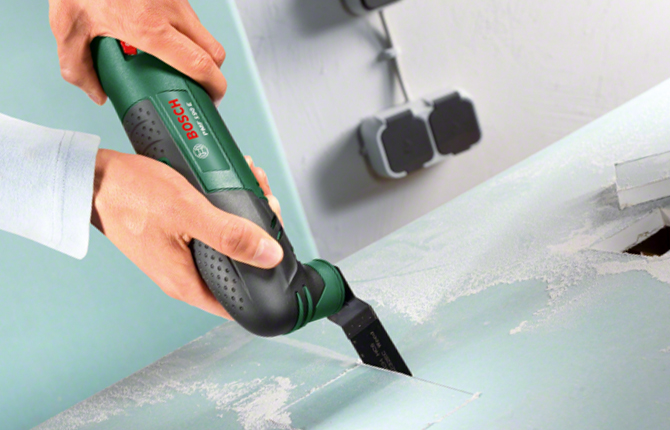
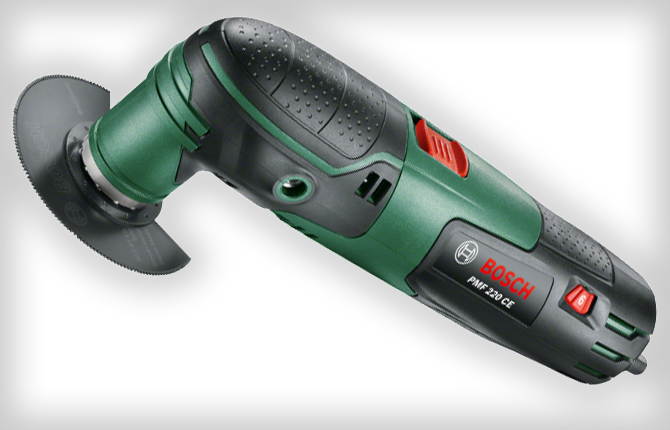
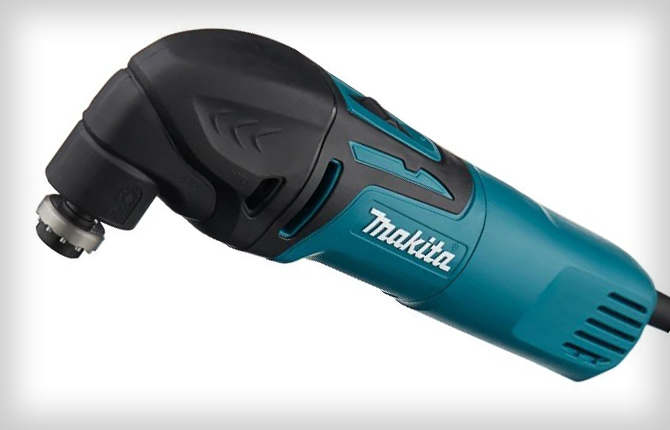



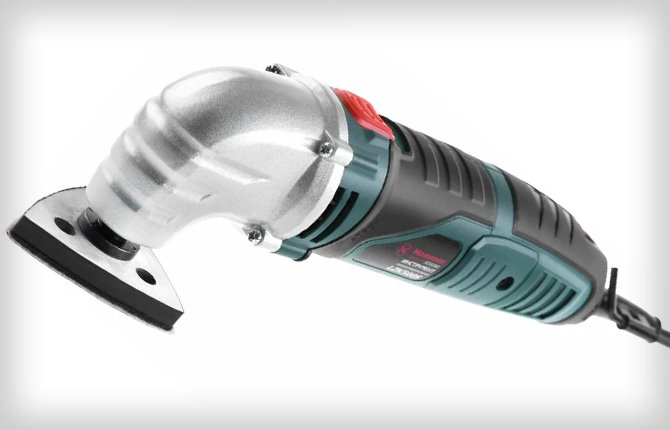
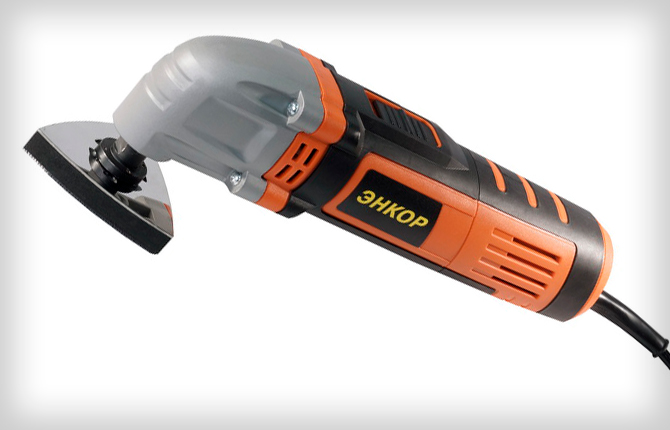







The BOSCH PMF is low-powered, but the high revs make up for it. It is convenient to work in corners when installing skirting boards.
I took a specially powerful Makita TM3000C. It has low speeds, just enough to work slowly but with less dust.
I spent a long time choosing, and the DeWALT DWE315 turned out to be a middle ground between the Chinese “toothpicks” and the Dora Makita. Just right for the home.